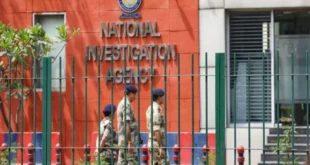New Delhi’24 May-On 12 May 2020, Prime Minister Narendra Modi gave the nation the mantra of the ‘Atmanirbhar Bharat Abhiyan’. In his address to the nation, he said “the state of the world today teaches us that Atma Nirbhar Bharat is the only path. Prime Minister Narendra Modi focussed on five pillars to make India self-reliant – economy, infrastructure, technology-driven system, vibrant demography and demand.
And the nation responded to his call very enthusiastically. For example, the PPE (especially face masks and body coveralls) were essential for survival in pandemic days. The country’s manufacturers stepped up and provided the industry with locally made technologies. They developed an automatic mask machine domestically, ending India’s dependence for such machines on other countries. India’s first fully automatic machine for N-95 masks was conceptualised, designed and built within a short period of just 3 weeks. All the components used to assemble the machine were local. A seventh semester student from National Institute of Fashion Technology (NIFT), Delhi, also manufactured the indigenous machines for mask and body coverall manufacturing.
Similarly, almost immediately after the announcement of the campaign, the largest telecom operator of India, Reliance Jio, announced that it had developed a 5G solution from the ground up.
All the five pillars are mutually complementary, still the futuristic vision of Atma Nirbhar Bharat is clearly driven by the third pillar- Technology-driven system. Not only the corona pandemic, but the later geopolitical situations too have proved the exigent nature of Atma Nirbhar Bharat.
And since then, India is rapidly becoming Atma Nirbhar in the Technology sector. In fact, the technology sector might decide the winners and losers of the current situation. The ‘Atmanirbhar Bharat Abhiyan’ gave a fresh boost to Make in India and the Start-up India missions. The agile, talented and ignited young Indian minds took off to entrepreneur ventures and have created an ecosystem of technology and innovation, which is now echoing world-wide. India has now nurtured several industry leaders in key technological sectors. With UPI and Aadhaar, India has successfully established publicly funded technologies. With RuPay India has an alternative to other cards, with a massive customer base. The RuPay payments system has already been exported and established in several other countries.
Another big story of Atmanirbhar Bharat is the Defence technology. The defence sector is not only important for national security, but it is also one of the critical sectors of the Indian economy. The government initiated various policy actions to boost indigenous design, development and manufacture of defence equipment in the country and make a sustainable defence industrial ecosystem. The process started through the revised Defence Acquisition Procedure (DAP)-2020. Import of thousands of items has been restricted. Innovations for Defence Excellence (iDEX) scheme was launched involving start-ups & Micro, Small and Medium Enterprises (MSMEs). The offset policy with thrust on attracting investment and Transfer of Technology for Defence manufacturing by assigning higher multipliers was restructured. Two dedicated Defence Industrial Corridors were created, one in U P and the other in TamilNadu. Ordnance Factory Board was restructured into seven new Defence Companies. The Defence Research and Development Organisation (DRDO) is transferring Free technology to private companies.
With these, and plethora of other policies and measures, India is now climbing high in the technological side of the defence sector. From Autonomous Vehicles and Unmanned Aerial Vehicles (drones), the Indian government is encouraging innovation and advancement with several success stories.
Induction of LCA (Tejas), Arudhra and Aslesha Radars, Astra Air to Air missile, Akash Surface to Air missile system, Advance Light Helicopter and Light Combat Helicopter etc. systems were added in IAF’s inventory.
The MBT ‘Arjun’ Mk-1A was handed over to the Indian Army by Prime Minister on 14 Feb 2021 and Ministry of Defence (MoD) placed an order with Heavy Vehicles Factory (HVF), Avadi, Chennai for supply of 118 Main Battle Tanks (MBTs) Arjun Mk-1A for Indian Army on September 23, 2021.
Advanced Electronic Warfare System ‘Shakti’, was handed over to the Indian Navy on 19 Nov 2021 by Prime Minister Narendra Modi.
Indigenous Aircraft Carrier ‘Vikrant’ successfully accomplished its maiden sea voyage in August 2021. This milestone with few parallels reinforces confidence in the largest indigenously designed platform of Indian Navy and the resolve of countrymen in our quest for ‘Atmanirbahar Bharat’. Commissioning of Vikrant is being targeted by August 15, 2022.
INS Visakhapatnam, first ship of Project 15B, was delivered by Mazagon Dock Limited to the Indian Navy on October 28, 2021.
Two sophisticated and potent platforms Karanj and Vela were commissioned on 10 Mar 2021 and 25 Nov 2021 respectively, with over 75 percent of Indigenous content, having State-of-the-art weapon fit to strengthen our security apparatus in the Western Seaboard.
From drones to soil treatment to nano fertilisers, the latest technology has entered in a big way in Indian agriculture and farming. The same is true for almost all the sectors, including railways to steel.
On 02nd July, 2021, The government launched six technology innovation platforms to focus on the development of technologies for globally competitive manufacturing in India. These platforms facilitate industry, including original equipment manufacturers, Tier 1, 2, and 3 companies and raw material makers, start-ups, domain experts/professionals, R&D institutions, and academia to provide technology solutions, suggestions, and opinions on issues involving manufacturing technologies. Thousands of students, experts, institutes, industries, and labs were registered on these platforms within no time.
The Government of India is working on new draft policies for Industrial e-commerce. The government wants industry to adopt new technologies to increase capacity and improve quality of products, besides moving towards the digital economy.
Council of Scientific and Industrial Research (CSIR) is developing a database and a virtual platform to bring on board the Global Indian S&T Community to address the Indian societal challenges / problems.
The virtual platform, a portal, is named PRABHASS, an acronym for “Pravasi Bharatiya Academic and Scientific Sampark”. This portal is to serve as a National Digital Platform to effectively collaborate with the Global Indian S&T Community for collectively promoting inclusive growth in India, strengthening Indian innovation ecosystem and contributing towards nation building.
Simultaneously, India has started much closer technological cooperation with other countries. For example, last month Prime Minister Narendra Modi and the European Commission’s President Ursula von der Leyen agreed to launch the EU-India Trade and Technology Council (TTC). The TTC is set up to explore more areas for joint projects, while emphasising the connection of two policy fields. The decision to set up a Trade and Technology Council is the first for India with any of its partners. Prior to this, even the European Union had only one of this kind- with the US.
India has already caused major changes in the technology landscape. Now India is very much part of the New Tech World Order.

 Pressmediaofindia
Pressmediaofindia



